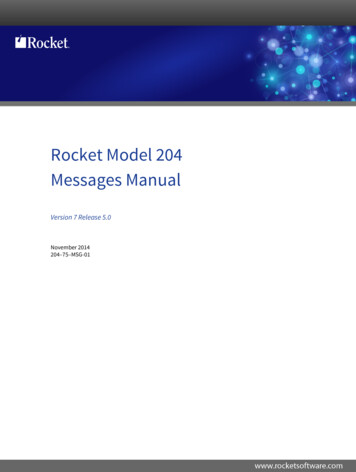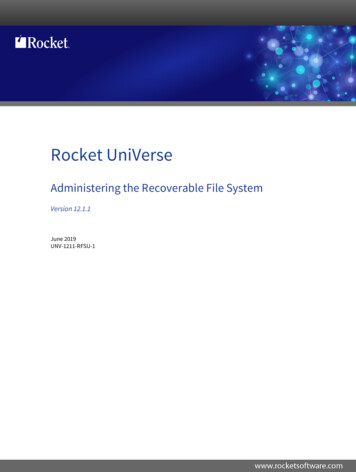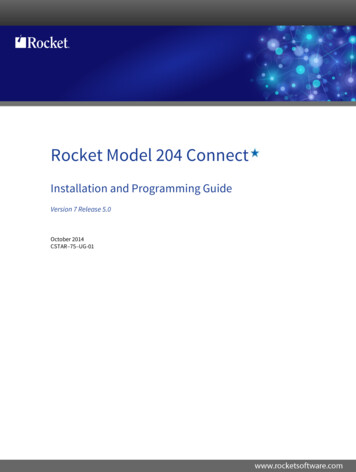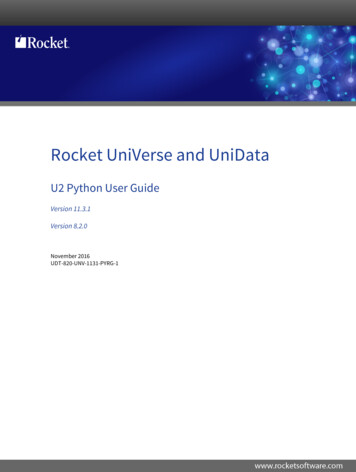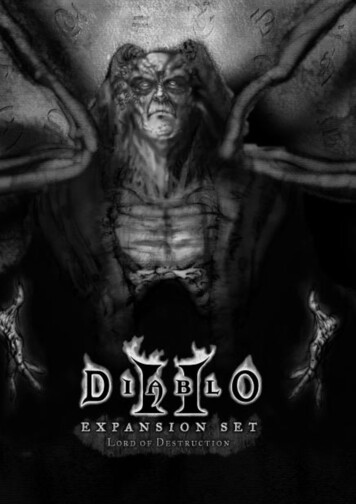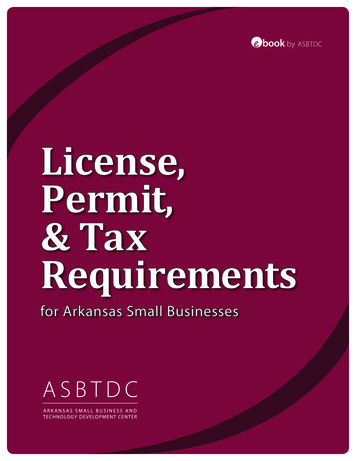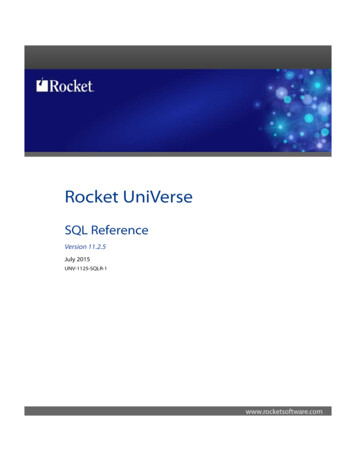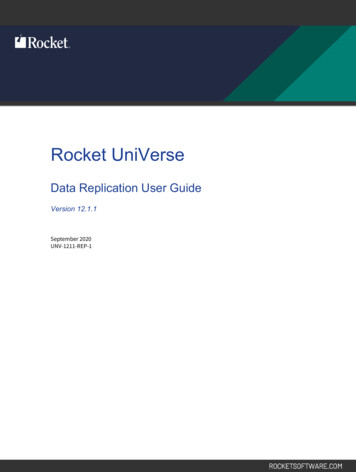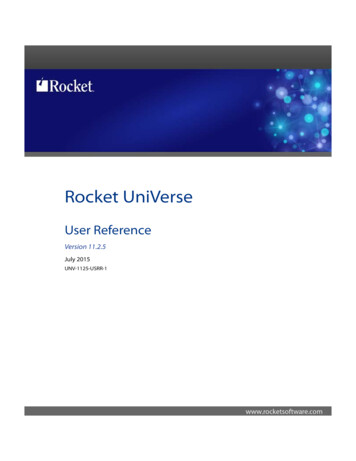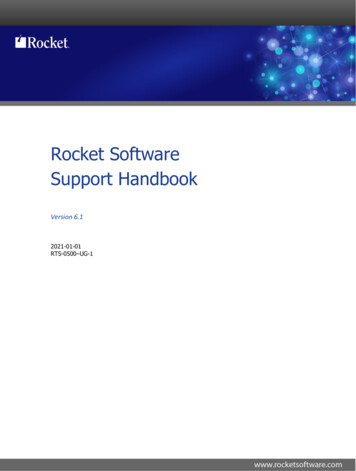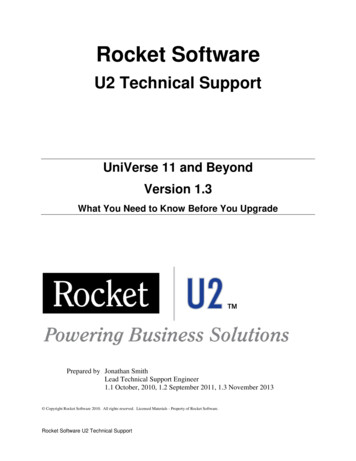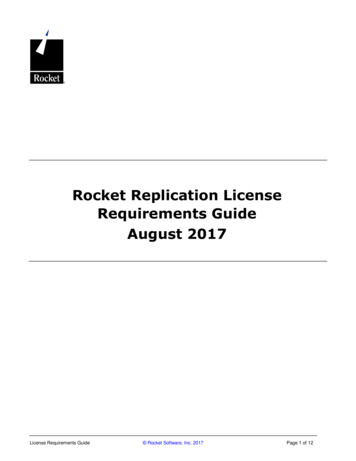
Transcription
Rocket Replication LicenseRequirements GuideAugust 2017License Requirements Guide Rocket Software, Inc. 2017Page 1 of 12
Table of ContentsContentsTable of Contents . 2Introduction . 3Definitions . 3License Guidelines . 3Standby Licenses . 4HA/DR Solutions . 4Configurations. 4Standard Backup . 6Virtualization Backup . 6Replication and Repurpose . 7U2 Replication – Single machine . 7U2 Replication – Separate machine(s) . 8D3 Hot Backup . 83rd Party Replication . 9Switching SAN #1. 9Switching SAN #2.10Standard Virtualization .10Multi-site Datacenter #1 .11Multi-site Datacenter #2 .11Conclusion .12Document History.12License Requirements Guide Rocket Software, Inc. 2017Page 2 of 12
IntroductionThis document describes several common Rocket MV Replication software configurationsand their impact on software license requirements.These guidelines discuss how to determine if your configuration requires the acquisition ofadditional matching or non-matching license(s) based on your license usage.For more information, email your Rocket sales representative, Rocket MV Distributor, oru2askus@rocketsoftware.com with any questions related to this document.DefinitionsFor the purposes of this document, the following definitions apply:Disaster Recovery – infrastructure set up to restore operations after a natural orhuman-induced disaster.High Availability – a machine architected to recover quickly in case of individualcomponent failures.Installed/Installation – Rocket Software programs are considered to be installed ifthey are placed in a position that does not require transfer from any other mediaand are ready to use. They do not need to be authorized to be ready to use.License – the specific configuration of options, features and user counts authorizedand used by the client.Serial Number – a unique number associated with the License that is issued to helpensure that the License is installed one time and using only the authorized options,features and user counts.Standard License – a license that has no usage limitations.Standby License – a limited use license available for High Availability/DisasterRecovery (HA/DR) solutions.License GuidelinesIn order to understand how many Licenses (Serial Numbers) are required and whether theLicenses must match, two basic questions must be answered:1)How many machines have software installed simultaneously?2)Is the software configured to support HA/DR?The basic guidelines for License acquisition are: A unique Serial Number for each installed program must be acquired for each machine.This includes stand-alone machines, replicated/mirrored machines (regardless oftechnology) and virtual machines (Workload Partitions (WPARs), Logical Partitions(LPARs), zones, etc.). If your configuration supports High Availability AND Disaster Recovery your Licensesmust have matching options, features and user counts.Finally, if two (2) Licenses, or more, of software are required and they must match, thereare two options:License Requirements Guide Rocket Software, Inc. 2017Page 3 of 12
1) Standard Licenses – Same software; options, features and user counts must match;no usage restrictions; standard pricing.2) Standby Licenses – Same software; options, features and user counts must match;limited use; discounted pricing.Standby LicensesStandby Licenses support UniData and UniVerse in a HA/DR configuration. Rocket Softwareoffers U2 Replication and Recoverable File System (RFS) technologies as well asProfessional Services to assist in implementation of high availability solutions.Regardless of the technology used to protect your D3, UniData or UniVerse solution withboth High Availability and Disaster Recovery, matching Licenses are required. MatchingLicenses can be either Standard Licenses or Standby Licenses. Standby Licenses, asdescribed below, may also be used, if desired, for solutions that provide:i)ii)only High Availability, oronly Disaster Recovery. A Standby License can mirror data, update files, and synchronize programs, data orother resources from the publisher machine. A Standby License can be used for development and testing (including failovertesting). A Standby license may also be used for the following read-only activities: reporting dashboards replication extractionThe Standby License may not be used for production or other operational uses.HA/DR SolutionsWhen you are running Rocket MV machine-based programs in a HA/DR configuration youmust acquire matching Licenses. The Licenses must have unique Serial Numbers and beconfigured identically (e.g. options, features, user counts and, maintenance status).Matching Licenses can be either Standard Licenses with no usage restrictions or StandbyLicenses with usage limitations as described below.Rocket MV machine-based programs comprise D3, UniData, UniVerse, U2 Web DE,SystemBuilder, and SB/XA.Note: This replaces all previous policies regarding Backup Programs.ConfigurationsYou may have Rocket MV machine-based programs installed on one or more machines fora variety of purposes including, but not limited to, report machine, data warehouse,development, testing, production, high availability and/or disaster recovery. An installationof Rocket MV machine-based programs may serve one or more of the above-mentioneduses.Depending on the configuration you may or may not be required to have a second uniqueLicense (Serial Number). If you are required to have a second License, it may or may notbe required to match.License Requirements Guide Rocket Software, Inc. 2017Page 4 of 12
The following Configuration table summarizes some of the combinations of uses and theirLicense requirements. Each configuration will be explained in more detail below the kupReplication &RepurposeU2 ReplicationSingle DatabaseU2 ReplicationSeparateDatabase(s)D3 Hot Backup3rd PartyReplicationSwitching SAN#1Switching SAN#2StandardVirtualizationMulti-siteDatacenter #1Multi-siteDatacenter #2HighDisaster Additional Licenses UniqueAvailability Recovery LicenseMustSerialRequired sYesYesYesYesYesYes1 – If the backup of your publisher machine is restored to another actively runningmachine while the publisher is still active, an additional unique serial number is required.2 - If you are replicating the entire publisher machine to the subscriber machine for thepurpose of HA/DR, you need multiple unique Serial Numbers and the Licenseconfigurations must match.License Requirements Guide Rocket Software, Inc. 2017Page 5 of 12
Standard BackupIn a standard backup configuration, the software is installed on only one machine. Themachine is periodically backed up to a separate media (e.g. tape or hard drive). Thisscenario supports disaster recovery but not high availability.In case of a disaster there are two options, 1) the backup may be restored to the publishermachine or, 2) if the publisher machine is not reparable, the data machine may have to beinstalled and configured on a subscriber machine before restoring the backup.For a standard backup configuration, only one license is required.Virtualization BackupBackups can also be done using virtualization technologies such as snapshots. In this case,the database is only installed on one machine at a time. In the example below, snapshotswere used to do the backup and restore in the case of a disaster. If the snapshot isrestored to a second machine, MV software may have to be installed and configured. Inthis scenario, only one License is required. This usage is considered to be disaster recoveryonly.License Requirements Guide Rocket Software, Inc. 2017Page 6 of 12
Replication and RepurposeMV software may be installed on two machines for the purpose of replicating data from thepublisher machine to be repurposed for reporting, etc. on a subscriber machine. In thiscase, there will be a selected subset of data being replicated for this subscriber purpose.This usage is neither high availability nor disaster recovery.In this configuration, you need two unique Serial Numbers and the Licenses do not need tomatch.U2 Replication – Single machineIn this configuration, the software is installed on a single, partitioned machine and U2Replication is being used to keep the installs in sync.In this configuration, there can only be a single unique Serial Number.License Requirements Guide Rocket Software, Inc. 2017Page 7 of 12
U2 Replication – Separate machine(s)In this configuration software is installed on two or more machines at the same time andU2 Replication is being used to keep the machines in sync. This configuration supportsboth HA/DR with the ability to quickly failover to the subscriber machine in case of adisaster as well as the ability to quickly fail back to the publisher machine upon recovery.In this configuration, you need multiple unique Serial Numbers and the Licenseconfigurations must match. They can either be Standard Licenses or Standby Licenses.D3 Hot BackupIn this configuration software is installed on two or more machines at the same time andD3 Hot Backup is being used to keep the machines in sync. This configuration supportsboth HA/DR with the ability to quickly failover to the subscriber machine in case of adisaster, as well as the ability to quickly fail back to the publisher machine upon recovery.Each subscriber requires a unique Serial Number, the License configurations must matchand they must be Standby Licenses.D3 Hot Backup on AIX and Linux supports the ability to daisy chain multiple subscribers,providing the capability to have subscribers in multiple locations for HA/DR capabilities. D3Hot Backup on Windows is limited to a single subscriber.License Requirements Guide Rocket Software, Inc. 2017Page 8 of 12
3rd Party ReplicationIn this configuration, software is installed on two machines and third party replicationtechnology is being used to keep the machines in sync. This configuration supports bothhigh availability and disaster recovery.In this configuration, you need unique Serial Numbers and the License configurations mustmatch. They can be either Standard Licenses or Standby Licenses.Switching SAN #1In this configuration, the MV database is installed on the Storage Attached Network (SAN)drive that is shared between two machines. In this scenario, only one machine can beactively accessing the MV database at any one time. This supports high availability butnot disaster recovery.In this configuration, only one Serial Number is required.License Requirements Guide Rocket Software, Inc. 2017Page 9 of 12
Switching SAN #2In this configuration, the MV database is installed on two machines at the same time. Theapplication data is stored on a shared SAN drive. This scenario supports high availabilitybut not disaster recovery.This configuration requires two unique Serial Numbers and the Licenses are not required tomatch.Standard VirtualizationIn this configuration, the software is installed on one virtual machine at a time. Theapplication data is stored on a shared SAN. In the case of a machine outage, the virtualmachine may be migrated from one physical machine to another. This scenario supportshigh availability but not disaster recovery.In this scenario, only one software License is required.License Requirements Guide Rocket Software, Inc. 2017Page 10 of 12
Multi-site Datacenter #1In this configuration, MV is installed on both SANs and the two SANs are being kept insync via mirroring or replication.This scenario supports both high availability and disaster recovery.In this scenario, two Licenses are required and they must match. The second License maybe either a Standard License or a Standby License.Multi-site Datacenter #2In this configuration, the software is installed on both the publisher and subscribermachine. The application files and data are stored on a SAN which is kept in sync with asecond SAN via mirroring or replication. This scenario supports both high availability anddisaster recovery.In this scenario, two MV software Licenses are required and they must match. The secondlicense may be either a Standard License or a Standby License.License Requirements Guide Rocket Software, Inc. 2017Page 11 of 12
ConclusionThis document shows several common Rocket configurations and their licensingrequirements; however, it is not possible to cover all configurations. If you are unsure ifyour configuration matches one of these, please see the general guidelines above. If youhave additional questions, please contact your Rocket software provider.Document HistoryThis section highlights the major changes in the current versionAugust 2017 Revised the Configuration table Added U2 Replication – Single database Added U2 Replication – Separate database(s) Added D3 Hot BackupLicense Requirements Guide Rocket Software, Inc. 2017Page 12 of 12
2) Standby Licenses – Same software; options, features and user counts must match; limited use; discounted pricing. Standby Licenses Standby Licenses support UniData and UniVerse in a HA/DR configuration. Rocket Softw
